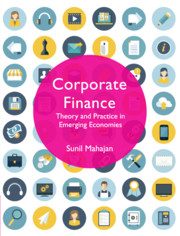Book contents
- Frontmatter
- Contents
- List of Figures
- List of Tables
- List of Corporate Snippets
- List of Abbreviations
- Preface
- Acknowledgements
- 1 Corporate Finance: A Conceptual Introduction
- 2 Financial Markets
- 3 The Time Value of Money
- 4 Capital Budgeting
- 5 Risk and Return
- 6 Valuation
- 7 Capital Structure and Financing
- 8 Dividend Payout: Policy and Practices
- 9 Leverage
- 10 Financial Derivatives
- 11 International Finance
- 12 Working Capital
- 13 Ratio Analysis
- Appendix
- Bibliography
- Index
13 - Ratio Analysis
Published online by Cambridge University Press: 30 April 2020
- Frontmatter
- Contents
- List of Figures
- List of Tables
- List of Corporate Snippets
- List of Abbreviations
- Preface
- Acknowledgements
- 1 Corporate Finance: A Conceptual Introduction
- 2 Financial Markets
- 3 The Time Value of Money
- 4 Capital Budgeting
- 5 Risk and Return
- 6 Valuation
- 7 Capital Structure and Financing
- 8 Dividend Payout: Policy and Practices
- 9 Leverage
- 10 Financial Derivatives
- 11 International Finance
- 12 Working Capital
- 13 Ratio Analysis
- Appendix
- Bibliography
- Index
Summary
Financial statements are like a fine perfume, to be sniffed but not swallowed.
—Abraham BrillofCorporations are complex entities which witness a constant interplay of the policies of the management with the external environment, leading eventually to financial outcomes. At times, the financial outcomes are in accordance with the objectives of the company; at other times, the two may diverge. Whether the desired outcomes are being realized or not, the management needs to continually analyse the performance of the company and consider ways to improve upon it.
Ratio analysis is a tool that is extensively used to scrutinize the performance of a company. Its extensive usage is a reflection of the easy understanding and wide applicability of the concept. A ratio is an arithmetical relationship between two numbers, the numbers being usually picked from the accounting statements. It is important to pick numbers that have a meaningful relationship with each other and whose ratio reveals some key performance parameters of the company. Else, the ratio would be irrelevant, even misleading.
All stakeholders—shareholders, bond holders, bankers, suppliers, employees, customers and, above all, the management—use ratios to monitor various aspects of the performance of the company. Different stakeholders use different ratios, appropriate to their specific requirements. Investors in the stock market are interested in market-based ratios such as the price earnings (P/E) ratio and the market price to book value ratio. Long-term lenders value leverage and debt service coverage ratio. Short-term lenders prefer liquidity and, therefore, are keen to know the current ratio and the quick ratio. No single ratio or set of ratios can be appropriate for all occasions and purposes.
The ratios we calculate and analyse should be appropriate for our objectives, be it performance evaluation, credit analysis or equity investment. Ratios are just numbers that tell us nothing by themselves. The interpretations of these numbers is critical and we must compare ratios across industries and over time in order to draw legitimate conclusions.
Let us try and look at ratios differently, basing our analysis on the return on equity (ROE). It is a key parameter of performance. Given the risk profile of the company, managers try to maximize the return investors get on their equity investments. Let us see how different ratios dovetail into and capture the ROE.
- Type
- Chapter
- Information
- Corporate FinanceTheory and Practice in Emerging Economies, pp. 299 - 315Publisher: Cambridge University PressPrint publication year: 2020



